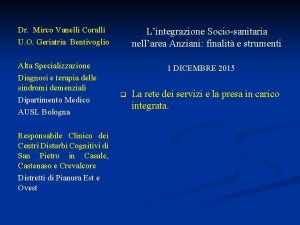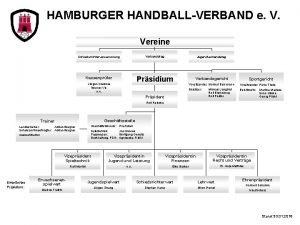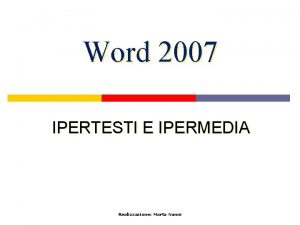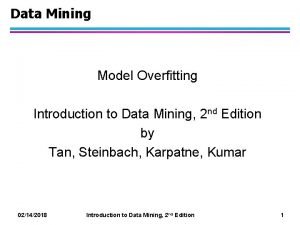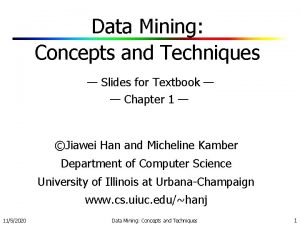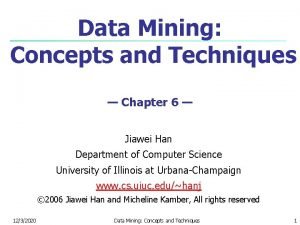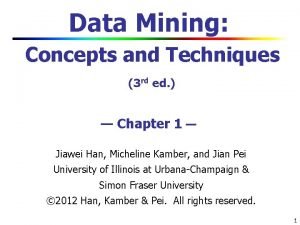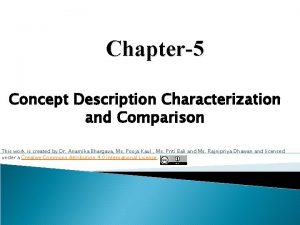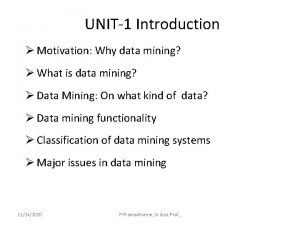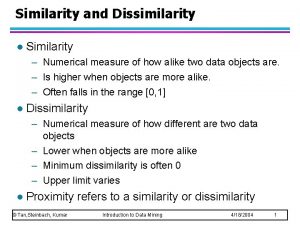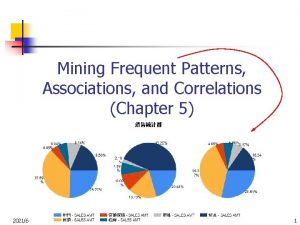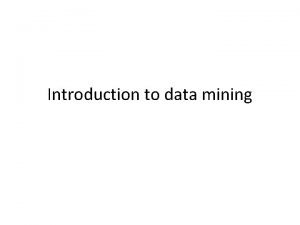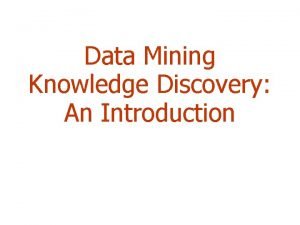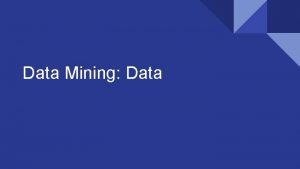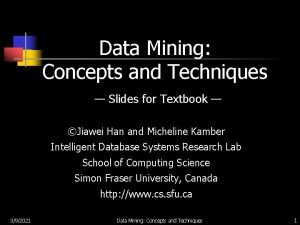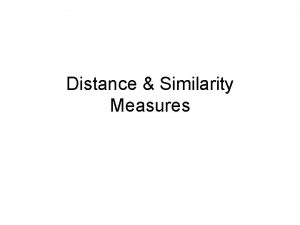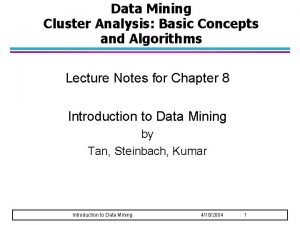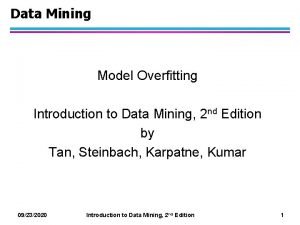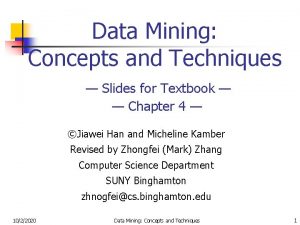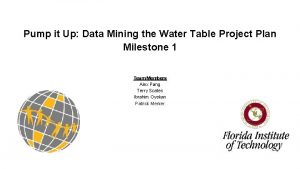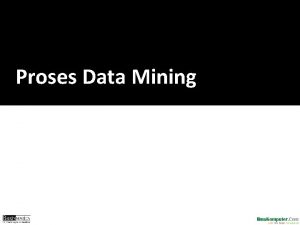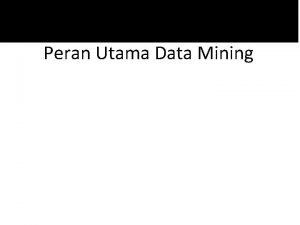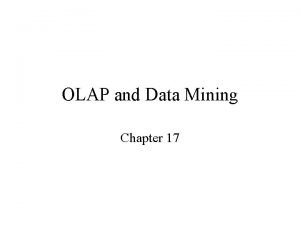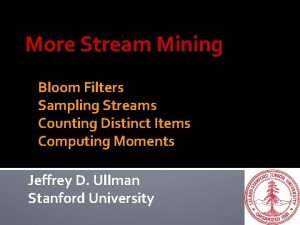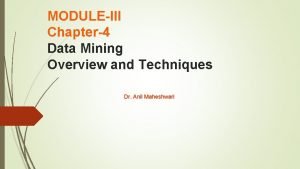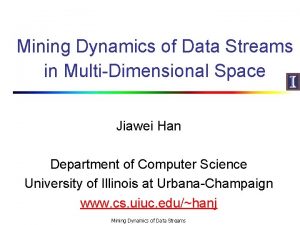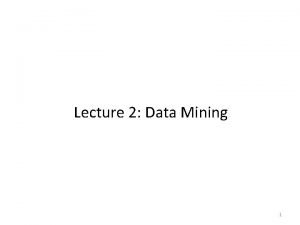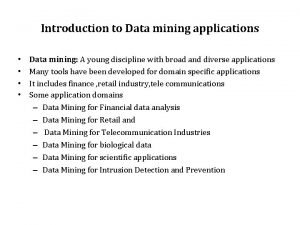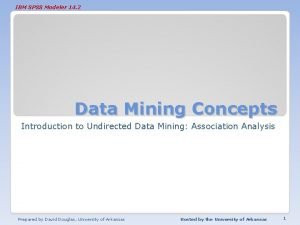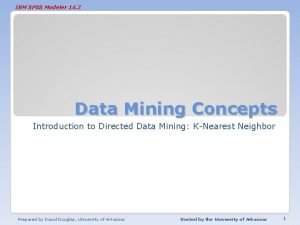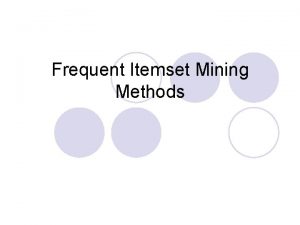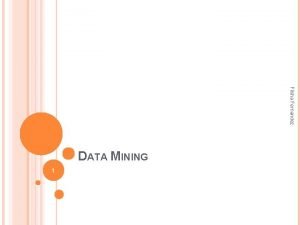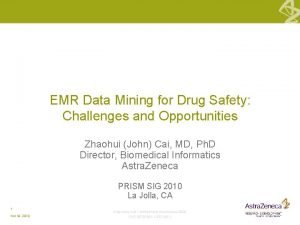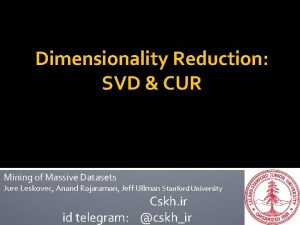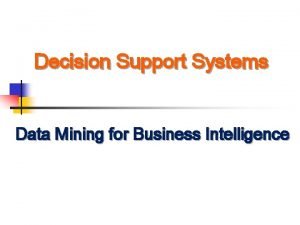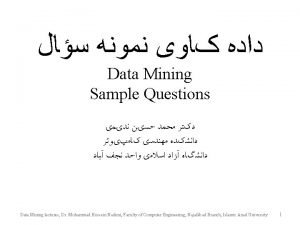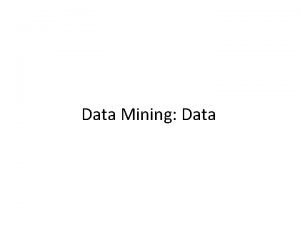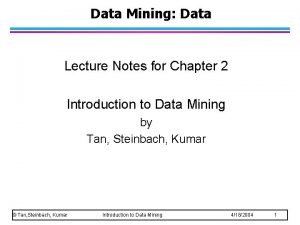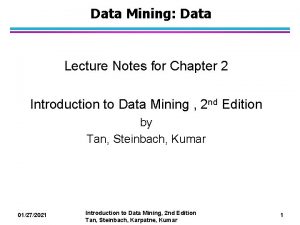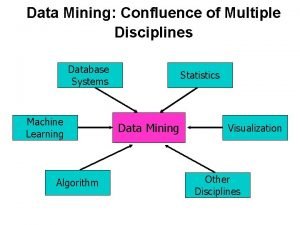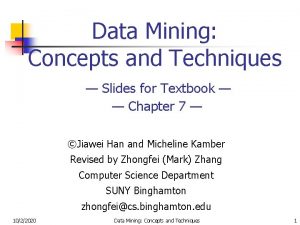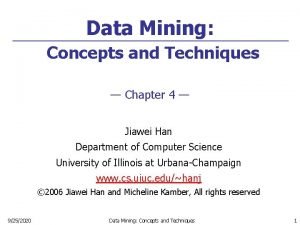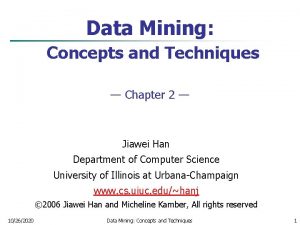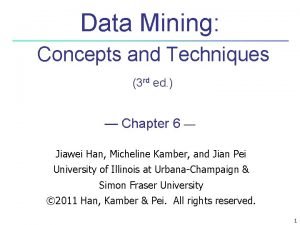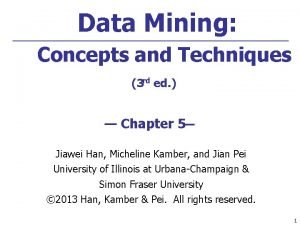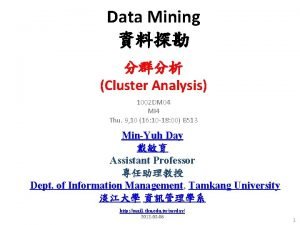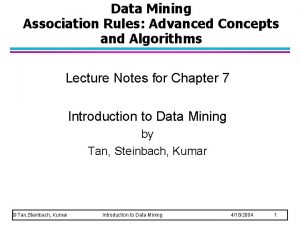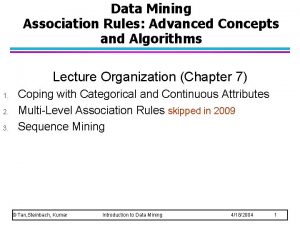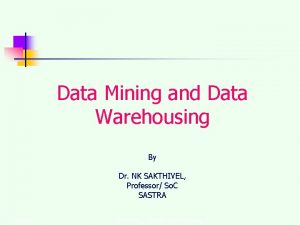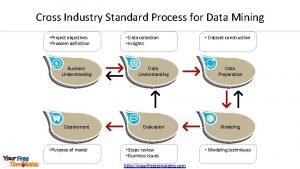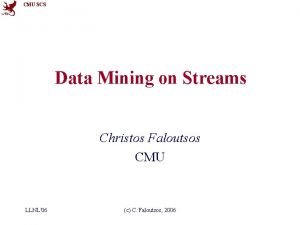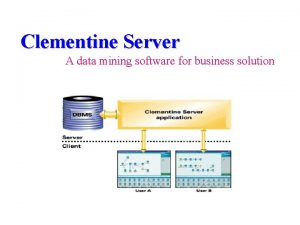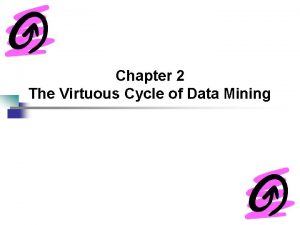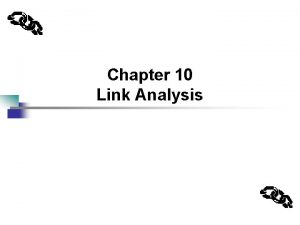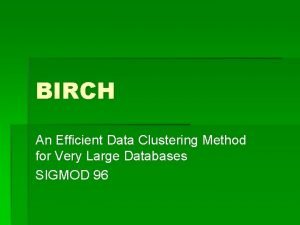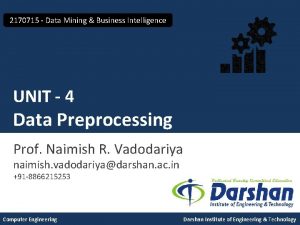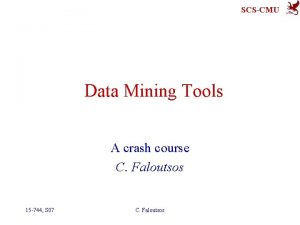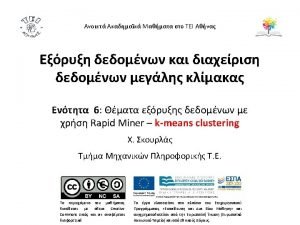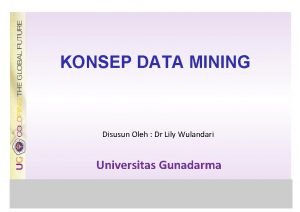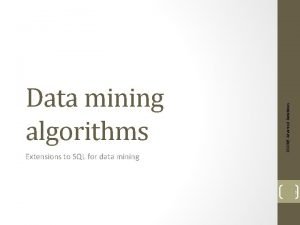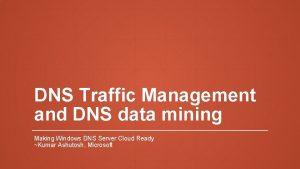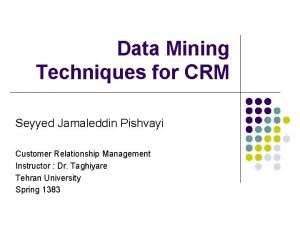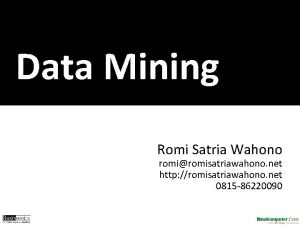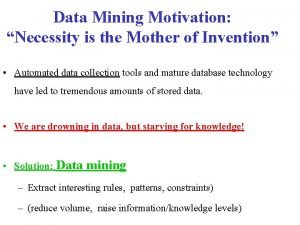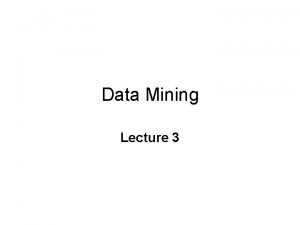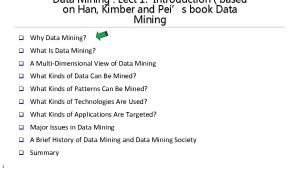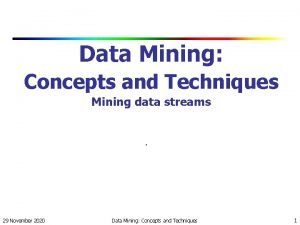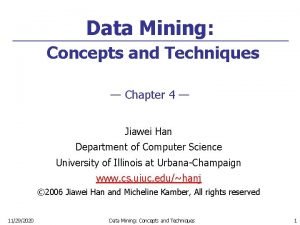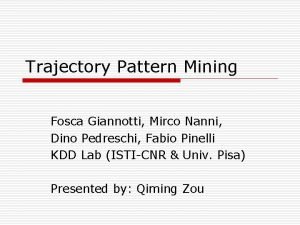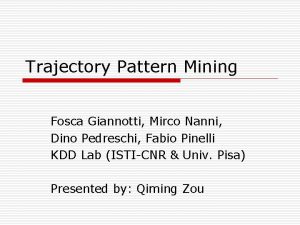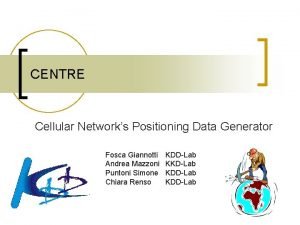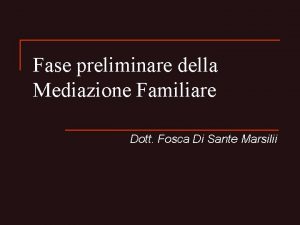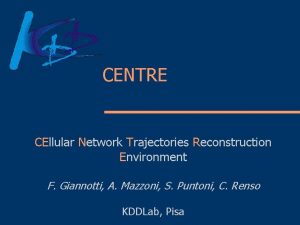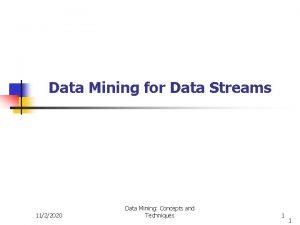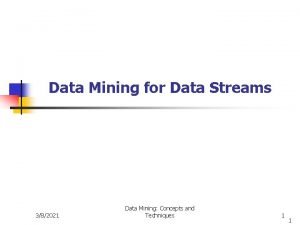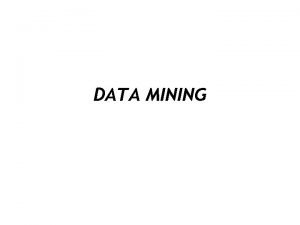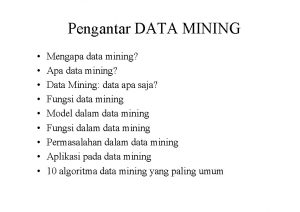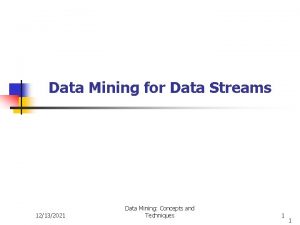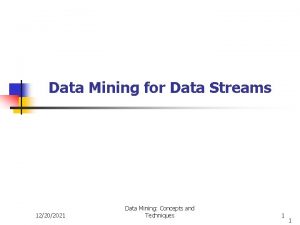Data Mining 2 Fosca Giannotti and Mirco Nanni




















































![Mobility data example: spatio-temporal linkage l [Jajodia et al. 2005] l An anonymous trajectory Mobility data example: spatio-temporal linkage l [Jajodia et al. 2005] l An anonymous trajectory](https://slidetodoc.com/presentation_image_h/14d92fa9d73bb342d7c718dfde79f8ca/image-53.jpg)


![An example of rule-based linkage [Atzori et al. 2005] l Age = 27 and An example of rule-based linkage [Atzori et al. 2005] l Age = 27 and](https://slidetodoc.com/presentation_image_h/14d92fa9d73bb342d7c718dfde79f8ca/image-56.jpg)





![k-Anonymity [SS 98]: Eliminate Link to Person through Quasiidentifiers Date of Birth Zip Code k-Anonymity [SS 98]: Eliminate Link to Person through Quasiidentifiers Date of Birth Zip Code](https://slidetodoc.com/presentation_image_h/14d92fa9d73bb342d7c718dfde79f8ca/image-62.jpg)

























































- Slides: 119

Data Mining 2 Fosca Giannotti and Mirco Nanni Pisa KDD Lab, ISTI-CNR & Univ. Pisa http: //www-kdd. isti. cnr. it/ DIPARTIMENTO DI INFORMATICA - Università di Pisa anno accademico 2012/2013

Privacy: Regulations and Privacy Aware Data Mining Giannotti & Nanni Anno accademico, 2011/2013 Reg. Ass. 2

Plan of the Talk l Privacy Constraints Sources: ¡ EU rules ¡ US rules ¡ Safe Harbor Bridge l Privacy Constraints Types: ¡ Individual (+ k-anonymity) ¡ Collection (Corporate privacy) ¡ Result limitation l Classes of solutions ¡ Brief State of the Art of PPDM l Knowledge Hiding l Data Perturbation and Obfuscation l Distributed Privacy Preserving Data Mining l Privacy-aware Knowledge Sharing

Data Scientist l … a new kind of professional has emerged, the data scientist, who combines the skills of software programmer, statistician and storyteller/artist to extract the nuggets of gold hidden under mountains of data. n Hal Varian, Google’s chief economist, predicts that the job of statistician will become the “sexiest” around. Data, he explains, are widely available; what is scarce is the ability to extract wisdom from them.


Cosa compriamo Cosa cerchiamo Con chi interagiamo Dove andiamo


Definition of privacy What is privacy? 8

Global Attention to Privacy l Time (August 1997) ¡The Death of Privacy l The Economist (May 1999) ¡The End of Privacy l The European Union (October 1998) ¡Directive on Privacy Protection l The European Union (January 2012) ¡Proposal for new Directive on Privacy Protection l New deal on personal data : World Economic Forum 2010 -2013 9

Time: The Death of Privacy l Invasion of privacy ¡Our right to be left alone has disappeared, bit by bit, in little brotherly steps. ¡Still, we've got something in return, and it's not all bad 10

The Economist l Remember, they are always watching you. Use cash when you can. Do not give your phone number, socialsecurity number or address, unless you absolutely have to. Do not fill in questionnaires or respond to telemarketers. Demand that credit and datamarketing firms produce all information they have on you, correct errors and remove you from marketing lists. 11

Web Users: Attitudes Do provide personal information 27% Never provide personal information 17% 56% Depending on privacy measures Source: Special Issue on Internet Privacy. Ed. L. F. Cranor (Feb 1999) 12

Web Users: Privacy vs Benefits 86% of Web Users believe that participation in information-forbenefits programs is a matter of individual privacy choice Having a privacy policy doesn’t matter as long as I got benefits 14% Privacy fundamentalists 4% 82% Having a privacy policy would matter Source: Freebies and privacy: What net users think. A. F. Westin (July 1999) 13


Definition of privacy What is privacy? 15

European legislation for protection of personal data l European directives: ¡Data protection directive (95/46/EC) and proposal for a new EU directive (25 Jan 2012) ¡http: //ec. europa. eu/justice/newsroom/dataprotection/news/120125_en. htm ¡e. Privacy directive (2002/58/EC) and its revision (2009/136/EC)

EU: Personal Data l Personal data is defined as any information relating to an identity or identifiable natural person. l An identifiable person is one who can be identified, directly or indirectly, in particular by reference to an identification number or to one or more factors specific to his physical, physiological, mental, economic, cultural or social identity.

EU: Processing of Personal Data l The processing of personal data is defined as any operation or set of operations which is performed upon personal data, whether or not by automatic means, such as: ¡ collection, ¡ use, ¡ recording, ¡ disclosure by transmission, ¡ organization, ¡ dissemination, ¡ storage, ¡ adaptation or alteration, ¡ alignment or combination, ¡ blocking, ¡ retrieval, ¡ erasure or destruction. ¡ consultation,

EU Privacy Directive requires: ¡ That personal data must be processed fairly and lawfully ¡ That personal data must be accurate ¡ That data be collected for specified, explicit and legitimate purposes and not further processed in a way incompatible with those purposes ¡ That personal data is to be kept in the form which permits identification of the subject of the data for no longer than is necessary for the purposes for which the data was collected or for which it was further processed ¡ That subject of the data must have given his unambiguous consent to the gathering and processing of the personal data ¡ If consent was not obtained from the subject of the data, that personal data be processed for the performance of a contract to which the subject of the data is a party ¡ That processing of personal data revealing racial or ethnical origin, political opinions, religious or philosophical beliefs, trade union membership, and the processing of data concerning health or sex life is prohibited

EU Privacy Directive l Personal data is any information that can be traced directly or indirectly to a specific person l Use allowed if: ¡ Unambiguous consent given ¡ Required to perform contract with subject ¡ Legally required ¡ Necessary to protect vital interests of subject ¡ In the public interest, or ¡ Necessary for legitimate interests of processor and doesn’t violate privacy l Some uses specifically proscribed (sensitive data) ¡ Can’t reveal racial/ethnic origin, political/religious beliefs, trade union membership, health/sex life

Anonymity according to 1995/46/EC l The principles of protection must apply to any information concerning an identified or identifiable person; l To determine whether a person is identifiable, account should be taken of all the means likely reasonably to be used either by the controller or by any other person to identify the said person; l The principles of protection shall not apply to data rendered anonymous in such a way that the data subject is no longer identifiable;

US Healthcare Information Portability and Accountability Act (HIPAA) l Governs use of patient information ¡ Goal is to protect the patient ¡ Basic idea: Disclosure okay if anonymity preserved l Regulations focus on outcome ¡A covered entity may not use or disclose protected health information, except as permitted or required… l To individual l For treatment (generally requires consent) l To public health / legal authorities ¡ Use permitted where “there is no reasonable basis to believe that the information can be used to identify an individual”

The Safe Harbor “atlantic bridge” l In order to bridge EU and US (different) privacy approaches and provide a streamlined means for U. S. organizations to comply with the European Directive, the U. S. Department of Commerce in consultation with the European Commission developed a "Safe Harbor" framework. l Certifying to the Safe Harbor will assure that EU organizations know that US companies provides “adequate” privacy protection, as defined by the Directive.

The Safe Harbor “atlantic bridge” l Data presumed not identifiable if 19 identifiers removed (§ 164. 514(b)(2)), e. g. : l Name, l location smaller than 3 digit postal code, l dates finer than year, l identifying numbers ¡ Shown not to be sufficient (Sweeney)

Privacy by design principle l In many cases (e. g. , all previous questions!), it is possible to reconcile the dilemma between privacy protection and knowledge sharing ¡Make data anonymous with reference to social mining goals ¡Use anonymous data to extract knowledge ¡Only a little loss in data quality often earns a strong privacy protection

e. Privacy Directive l GOAL: ¡the protection of natural and legal persons w. r. t. the processing of personal data in connection with the provision of publicly available electronic communications services in public communications networks.

Topics related to (mobility) Data Mining l Location data ¡ any data processed indicating the geographic position of the terminal equipment of a user of a publicly available electronic communications service l Traffic Data ¡ any data processed for the purpose of the conveyance of a communication on an electronic communications network or for the billing thereof l Value added Services ¡ any service which requires the processing of traffic data or location data other than traffic data beyond what is necessary for the transmission of a communication or the billing thereof l Examples: route guidance, traffic information, weather forecasts and tourist information.

Location/Traffic Data Anonymization l Location data and Traffic data must be erased or made anonymous when it is no longer needed for the purpose of the transmission of a communication and the billing l Location/Traffic Data anonymization for providing Value added Services

EU Directive (95/46/EC) and new Proposal l. GOALS: ¡protection of individuals with regard to the processing of personal data ¡the free movement of such data

New Elements in the EU Proposal l Principle of Transparency l Data Portability l Right of Oblivion l Profiling l Privacy by Design

Transparency & Data Portability l Transparency: ¡Any information addressed to the public or to the data subject should be easily accessible and easy to understand l Data Portability: ¡The right to transmit his/her personal data from an automated processing system, into another one

Oblivion & Profiling l Right to Oblivion: ¡The data subject shall have the right to obtain the erasure of his/her personal data and the abstention from further dissemination of such data l Profiling: ¡The right not to be subject to a measure which is based on profiling by means of automated processing

Privacy by Design l The controller shall implement appropriate technical and organizational measures and procedures in such a way that the data processing ¡will meet the requirements of this Regulation ¡will ensure the protection of the rights of the data subject

Privacy by Design in Data Mining l Design frameworks ¡to counter the threats of privacy violation ¡without obstructing the knowledge discovery opportunities of data mining technologies l Trade-off between privacy quantification and data utility

Privacy by Design in Data Mining The framework is designed with assumptions about

Plan of the Talk l Privacy Constraints Sources: ¡ EU rules ¡ US rules ¡ Safe Harbor Bridge l Privacy Constraints Types: ¡ Individual (+ k-anonymity) ¡ Collection (Corporate privacy) ¡ Result limitation l Classes of solutions ¡ Brief State of the Art of PPDM l Knowledge Hiding l Data Perturbation and Obfuscation l Distributed Privacy Preserving Data Mining l Privacy-aware Knowledge Sharing

Traces l Our everyday actions leave digital traces into the information systems of ICT service providers. ¡ mobile phones and wireless communication, ¡ web browsing and e-mailing, ¡ credit cards and point-of-sale e-transactions, ¡ e-banking ¡ electronic administrative transactions and health records, ¡ shopping transactions with loyalty cards

Traces: forget or remember? l When no longer needed for service delivery, traces can be either forgotten or stored. ¡ Storage is cheaper and cheaper. l But why should we store traces? ¡ From business-oriented information – sales, customers, billing-related records, … ¡ To finer grained process-oriented information about how a complex organization works. l Traces are worth being remembered because they may hide precious knowledge about the processes which govern the life of complex economical or social systems.

THE example: wireless networks l Wireless phone networks gather highly informative traces about the human mobile activities in a territory ¡ miniaturization ¡ pervasiveness l 1. 5 billions in 2005, still increasing at a high speed l Italy: # mobile phones ≈ # inhabitants ¡ positioning accuracy l location technologies capable of providing increasingly better estimate of user location

THE example: wireless networks l The Geo. PKDD – KDubiq scenario l From the analysis of the traces of our mobile phones it is possible to reconstruct our mobile behaviour, the way we collectively move l This knowledge may help us improving decision-making in mobility-related issues: ¡ Planning traffic and public mobility systems in metropolitan areas; ¡ Planning physical communication networks ¡ Localizing new services in our towns ¡ Forecasting traffic-related phenomena ¡ Organizing logistics systems ¡ Avoid repeating mistakes ¡ Timely detecting changes.

Opportunities and threats l Knowledge may be discovered from the traces left behind by mobile users in the information systems of wireless networks. l Knowledge, in itself, is neither good nor bad. l What knowledge to be searched from digital traces? For what purposes? l Which eyes to look at these traces with?

The Spy and the Historian l The malicious eyes of the Spy – or the detective – aimed at ¡ discovering the individual knowledge about the behaviour of a single person (or a small group) ¡ for surveillance purposes. l The benevolent eyes of the Historian – or the archaeologist, or the human geographer – aimed at ¡ discovering the collective knowledge about the behaviour of whole communities, ¡ for the purpose of analysis, of understanding the dynamics of these communities, the way they live.

The privacy problem l the donors of the mobility data are ourselves the citizens, l making these data available, even for analytical purposes, would put at risk our own privacy, our right to keep secret ¡ the places we visit, ¡ the places we live or work at, ¡ the people we meet ¡. . .

The naive scientist’s view (1) l Knowing the exact identity of individuals is not needed for analytical purposes ¡ Anonymous trajectories are enough to reconstruct aggregate movement behaviour, pertaining to groups of people. l Is this reasoning correct? l Can we conclude that the analyst runs no risks, while working for the public interest, to inadvertently put in jeopardy the privacy of the individuals?

Unfortunately not! l Hiding identities is not enough. l In certain cases, it is possible to reconstruct the exact identities from the released data, even when identities have been removed and replaced by pseudonyms. l A famous example of re-identification by L. Sweeney

Re-identifying “anonymous” data (Sweeney ’ 01) l She purchased the voter registration list for Cambridge Massachusetts ¡ 54, 805 people l 69% unique on postal code and birth date l 87% US-wide with all three (ZIP + birth date + Sex) l Solution: k-anonymity ¡ Any combination of values appears at least k times l Developed systems that guarantee k-anonymity ¡ Minimize distortion of results

Private Information in Publicly Available Data Date of Birth Zip Code Allergy 03 -24 -79 07030 Penicillin 08 -02 -57 07028 No Allergy 11 -12 -39 07030 No Allergy 08 -02 -57 08 -01 -40 07029 07030 Sulfur No Allergy Medical Research Database History of Illness Pharyngitis Stroke Polio Diphtheria Colitis Sensitive Information

Linkage attack: Link Private Information to Person Quasi-identifiers 08 -02 -57 Date of Birth Zip Code Allergy History of Illness 03 -24 -79 07030 Penicillin Pharyngitis 08 -02 -57 07028 11 -12 -39 07030 No Allergy Polio 08 -02 -57 07029 Sulfur Diphtheria 08 -01 -40 07030 No Allergy Colitis 07028 No Allergy Stroke Victor is the only person born 08 -02 -57 in the area of 07028… Ha, he has a history of stroke!

Sweeney’s experiment l Consider the governor of Massachusetts: ¡only 6 persons had his birth date in the joined table (voter list), ¡only 3 of those were men, ¡and only … 1 had his own ZIP code! l The medical records of the governor were uniquely identified from legally accessible sources!

The naive scientist’s view (2) l Why using quasi-identifiers, if they are dangerous? l A brute force solution: replace identities or quasi-identifiers with totally unintelligible codes l Aren’t we safe now? l No! Two examples: ¡The AOL August 2006 crisis ¡Movement data

A face is exposed for AOL searcher no. 4417749 [New York Times, August 9, 2006] l No. 4417749 conducted hundreds of searches over a three months period on topics ranging from “numb fingers” to “ 60 single men” to “dogs that urinate on everything”. l And search by search, click by click, the identity of AOL user no. 4417749 became easier to discern. There are queries for “landscapers in Lilburn, Ga”, several people with the last name Arnold and “homes sold in shadow lake subdivision gwinnet county georgia”.

A face is exposed for AOL searcher no. 4417749 [New York Times, August 9, 2006] l It did not take much investigating to follow this data trail to Thelma Arnold, a 62 -yearold widow of Lilburn, Ga, who loves her three dogs. “Those are my searches, ” she said, after a reporter read part of the list to her. l Ms. Arnold says she loves online research, but the disclosure of her searches has left her disillusioned. In response, she plans to drop her AOL subscription. “We all have a right to privacy, ” she said, “Nobody should have found this all out. ” l http: //data. aolsearchlogs. com
![Mobility data example spatiotemporal linkage l Jajodia et al 2005 l An anonymous trajectory Mobility data example: spatio-temporal linkage l [Jajodia et al. 2005] l An anonymous trajectory](https://slidetodoc.com/presentation_image_h/14d92fa9d73bb342d7c718dfde79f8ca/image-53.jpg)
Mobility data example: spatio-temporal linkage l [Jajodia et al. 2005] l An anonymous trajectory occurring every working day from location A in the suburbs to location B downtown during the morning rush hours and in the reverse direction from B to A in the evening rush hours can be linked to ¡ the persons who live in A and work in B; l If locations A and B are known at a sufficiently fine granularity, it possible to identify specific persons and unveil their daily routes ¡ Just join phone directories l In mobility data, positioning in space and time is a powerful quasi identifier.

The naive scientist’s view (3) l In the end, it is not needed to disclose the data: the (trusted) analyst only may be given access to the data, in order to produce knowledge (mobility patterns, models, rules) that is then disclosed for the public utility. l Only aggregated information is published, while source data are kept secret. l Since aggregated information concerns large groups of individuals, we are tempted to conclude that its disclosure is safe.

Wrong, once again! l Two reasons (at least) l For movement patterns, which are sets of trajectories, the control on space granularity may allow us to re-identify a small number of people ¡ Privacy (anonymity) measures are needed! l From rules with high support (i. e. , concerning many individuals) it is sometimes possible to deduce new rules with very limited support, capable of identifying precisely one or few individuals
![An example of rulebased linkage Atzori et al 2005 l Age 27 and An example of rule-based linkage [Atzori et al. 2005] l Age = 27 and](https://slidetodoc.com/presentation_image_h/14d92fa9d73bb342d7c718dfde79f8ca/image-56.jpg)
An example of rule-based linkage [Atzori et al. 2005] l Age = 27 and ZIP = 45254 and Diagnosis = HIV Native Country = USA [sup = 758, conf = 99. 8%] l Apparently a safe rule: ¡ 99. 8% of 27 -year-old people from a given geographic area that have been diagnosed an HIV infection, are born in the US. l But we can derive that only the 0. 2% of the rule population of 758 persons are 27 -year-old, live in the given area, have contracted HIV and are not born in the US. ¡ 1 person only! (without looking at the source data) l The triple Age, ZIP code and Native Country is a quasi-identifier, and it is possible that in the demographic list there is only one 27 -year-old person in the given area who is not born in the US (as in the governor example!)

Moral: protecting privacy when disclosing information is not trivial l Anonymization and aggregation do not necessarily put ourselves on the safe side from attacks to privacy l For the very same reason the problem is scientifically attractive – besides socially relevant. l As often happens in science, the problem is to find an optimal trade-off between two conflicting goals: ¡ obtain precise, fine-grained knowledge, useful for the analytic eyes of the Historian; ¡ obtain imprecise, coarse-grained knowledge, useless for the sharp eyes of the Spy.

Privacy-preserving data publishing and mining l Aim: guarantee anonymity by means of controlled transformation of data and/or patterns ¡little distortion that avoids the undesired sideeffect on privacy while preserving the possibility of discovering useful knowledge. l An exciting and productive research direction.

Privacy-preserving data publishing : K-Anonymity

Motivation: Private Information in Publicly Available Data Date of Birth Zip Code Allergy 03 -24 -79 07030 Penicillin 08 -02 -57 07028 No Allergy 11 -12 -39 07030 No Allergy 08 -02 -57 08 -01 -40 07029 07030 Sulfur No Allergy Medical Research Database History of Illness Pharyngitis Stroke Polio Diphtheria Colitis Sensitive Information

Security Threat: May Link Private Information to Person Quasi-identifiers 08 -02 -57 Date of Birth Zip Code Allergy History of Illness 03 -24 -79 07030 Penicillin Pharyngitis 08 -02 -57 07028 11 -12 -39 07030 No Allergy Polio 08 -02 -57 07029 Sulfur Diphtheria 08 -01 -40 07030 No Allergy Colitis 07028 No Allergy Stroke Victor is the only person born 08 -02 -57 in the area of 07028… Ha, he has a history of stroke!
![kAnonymity SS 98 Eliminate Link to Person through Quasiidentifiers Date of Birth Zip Code k-Anonymity [SS 98]: Eliminate Link to Person through Quasiidentifiers Date of Birth Zip Code](https://slidetodoc.com/presentation_image_h/14d92fa9d73bb342d7c718dfde79f8ca/image-62.jpg)
k-Anonymity [SS 98]: Eliminate Link to Person through Quasiidentifiers Date of Birth Zip Code Allergy History of Illness * 08 -02 -57 07030 0702* Penicillin No Allergy Pharyngitis Stroke * 08 -02 -57 * 07030 0702* 07030 No Allergy Sulfur No Allergy Polio Diphtheria Colitis k(=2 in this example)-anonymous table

Property of k-anonymous table l Each value of quasi-identifier attributes appears ≥ k times in the table (or it does not appear at all) Each row of the table is hidden in ≥ k rows Each person involved is hidden in ≥ k peers

k-Anonymity Protects Privacy Date of Birth 08 -02 -57 Zip Code Allergy No Allergy Penicillin History of Illness 0702* * 07030 08 -02 -57 0702* No Allergy Stroke * 07030 No Allergy Polio 08 -02 -57 0702* * 07030 Sulfur No Allergy Stroke Pharyngitis Diphtheria Colitis Which of them is Victor’s record? Confusing…

k-anonymity – Problem Definition o Input: Database consisting of n rows, each with m attributes drawn from a finite alphabet. o Assumption: the data owner knows/indicates which of the m attributes are Quasi-Identifiers. o Goal: trasform the database in such a way that is Kanonymous w. r. t. a given k, and the QIs. o How: By means of generalization and suppression. o Objective: Minimize the distortion. o Complexity: NP-Hard. o A lot of papers on k-anonymity in 2004 -2006 (SIGMOD, VLDB, ICDE, ICDM)

Privacy Preserving Data Mining: Short State of the Art

Privacy Preserving Data Mining l Very Short Definition: “the study of data mining side-effects on privacy” l A Bit Longer Definition: “the study of how to produce valid mining models and patterns without disclosing private information” ¡ Requires to define what is “private”… ¡ Many different definitions… ¡ … many different aproaches to Privacy Preserving Data Mining

Privacy Preserving Data Mining l We identify 4 main approaches, distinguished by the following questions: ¡ ¡ ¡ 1. 2. 3. 4. what is disclosed/published/shared? what is hidden? how is the data organized? (centralized or distributed) Knowledge Hiding Data Perturbation and Obfuscation Distributed Privacy Preserving Data Mining Privacy-aware Knowledge Sharing

A taxonomy tree…

And another one…

Knowledge Hiding

Knowledge Hiding l What is disclosed? ¡ the data (modified somehow) l What is hidden? ¡ some “sensitive” knowledge (i. e. secret rules/patterns) l How? ¡ usually by means of data sanitization l the data which we are going to disclose is modified in such a way that the sensitive knowledge can non longer be inferred, l while the original database is modified as less as possible.

Knowledge Hiding: Association Rules l This approach can be instantiated to association rules as follows: ¡ D source database; ¡ R a set of association rules that can be mined from D; ¡ Rh a subset of R which must be hidden. ¡ Problem: how to transform D into D’ (the database we are going to disclose) in such a way that R/ Rh can be mined from D’.

Knowledge Hiding l E. Dasseni, V. S. Verykios, A. K. Elmagarmid, and E. Bertino. Hiding association rules by using confidence and support. In Proceedings of the 4 th International Workshop on Information Hiding, 2001. l Y. Saygin, V. S. Verykios, and C. Clifton. Using unknowns to prevent discovery of association rules. SIGMOD Rec. , 30(4), 2001. l S. R. M. Oliveira and O. R. Zaiane. Protecting sensitive knowledge by data sanitization. In Third IEEE International Conference on Data Mining (ICDM’ 03), 2003. l O. Abul, M. Atzori, F. Bonchi, F. Giannotti: Hiding Sequences. ICDE Workshops 2007

Hiding association rules by using confidence and support E. Dasseni, V. S. Verykios, A. K. Elmagarmid, and E. Bertino 75

Scenario Data Mining Association Rules Hide Sensitive Rules User Changed Database

Association Rule Discovery

Knowledge Hiding Consider a transactional database D involving a set of transactions T. Each transaction involves some items from the set I = {1, 2, 3, 4}. Association Rule Mining is the data mining process involving the identification of sets of items (a. k. a. itemsets) that frequently co-occur in the set of transactions T (a. k. a. frequent itemset mining), and constructing rules among them that hold under certain levels of support and confidence. The whole set of potentially frequent itemsets involving 4 items is demonstrated in the lattice structure shown below. The original database D is also presented. D {1} {2} {3} {4} T 1 1 1 0 0 T 2 0 1 T 3 1 0 1 1 T 4 1 0 0 1 T 5 1 1 0 0 T 6 0 1 1 0 T 7 0 0 1 0

Suppose that we set the minimum support count to 2. Then, the following itemsets are said to be frequent: itemset support We separate the frequent from the infrequent itemsets in the lattice, using a borderline (red color). {1} 4 {2} 4 {3} 3 Now, suppose that itemsets {3} and {1, 4} are sensitive, meaning that they contain knowledge which the owner of the data wants to keep private! {4} 3 {1, 2} 2 {1, 4} 2 To do so, one needs to make sure that no rules will be produced by Apriori that contain any of these item sets. The new – ideal borderline is shown in the lattice in blue color. In order to hide all sensitive rules, the supporting sensitive itemsets need to be made infrequent in D. This is accomplished through data sanitization, by selectively altering transactions in D that support these itemsets.

D {1} {2} {3} {4} T 1 1 1 0 0 T 2 0 1 T 3 ? 0 ? ? T 4 ? 0 0 ? T 5 1 1 0 0 T 6 0 1 ? 0 T 7 0 0 ? 0 An intermediate form of the database is shown above, where all transactions supporting sensitive item sets {3} and {1, 4} have the corresponding ‘ 1’s turned into ‘? ’. Some of these ‘? ’ will later on be turned into zeros, thus reducing the support of the sensitive item sets. Heuristics exist to properly select which of the above transactions, namely {T 3, T 4, T 6, T 7} will be sanitized, to which extent (meaning how many items will be affected) and in which relative order, to ensure that the resulting database no longer allows the identification of the sensitive item sets (hence the production of sensitive rules) at the same support threshold.

Knowledge Hiding l Heuristics do not guarantee (in any way) the identification of the best possible solution. However, they are usually fast, generally computationally inexpensive and memory efficient, and tend to lead to good overall solutions. l An important aspect in knowledge hiding is that a solution always exists! This means that whichever itemsets (or rules) an owner wishes to hide prior sharing his/her data set with others, there is an applicable database D’ that will allow this to happen. The easiest way to see that is by turning all ‘ 1’s to ‘ 0’s in all the ‘sensitive’ items of the transactions supporting the sensitive itemsets. l Since a solution always exists, the target of knowledge hiding algorithms is to successfully hide the sensitive knowledge while minimizing the impact the sanitization process has on the nonsensitive knowledge! l Several heuristics can be found in the scientific literature that allow for efficient hiding of sensitive itemsets and rules.

Data Perturbation and Obfuscation

Data Perturbation and Obfuscation l What is disclosed? ¡ the data (modified somehow) l What is hidden? ¡ the real data l How? ¡ by perturbating the data in such a way that it is not possible the identification of original database rows (individual privacy), but it is still possible to extract valid intensional knowledge (models and patterns). ¡ A. K. A. “distribution reconstruction”

Data Perturbation and Obfuscation l R. Agrawal and R. Srikant. Privacy-preserving data mining. In Proceedings of SIGMOD 2000. l D. Agrawal and C. C. Aggarwal. On the design and quantification of privacy preserving data mining algorithms. In Proceedings of PODS, 2001. l W. Du and Z. Zhan. Using randomized response techniques for privacy-preserving data mining. In Proceedings of SIGKDD 2003. l A. Evfimievski, J. Gehrke, and R. Srikant. Limiting privacy breaches in privacy preserving data mining. In Proceedings of PODS 2003. l A. Evfimievski, R. Srikant, R. Agrawal, and J. Gehrke. Privacy preserving mining of association rules. In Proceedings of SIGKDD 2002. l Kun Liu, Hillol Kargupta, and Jessica Ryan. Random Projection-based Multiplicative Perturbation for Privacy Preserving Distributed Data Mining. IEEE Transactions on Knowledge and Data Engineering (TKDE), VOL. 18, NO. 1. l K. Liu, C. Giannella and H. Kargupta. An Attacker's View of Distance Preserving Maps for Privacy Preserving Data Mining. In Proceedings of PKDD’ 06

Data Perturbation and Obfuscation l This approach can be instantiated to association rules as follows: ¡ D source database; ¡ R a set of association rules that can be mined from D; ¡ Problem: define two algorithms P and MP such that l P(D) = D’ where D’ is a database that do not disclose any information on singular rows of D; l MP(D’) = R

Decision Trees Agrawal and Srikant ‘ 00 l Assume users are willing to ¡ Give true values of certain fields ¡ Give modified values of certain fields l Practicality ¡ 17% refuse to provide data at all ¡ 56% are willing, as long as privacy is maintained ¡ 27% are willing, with mild concern about privacy l Perturb Data with Value Distortion ¡ User provides xi+r instead of xi ¡ r is a random value l Uniform, uniform distribution between [- , ] l Gaussian, normal distribution with = 0,

Randomization Approach Overview Alice’s age Add random number to Age 30 becomes 65 (30+35) 30 | 70 K |. . . 50 | 40 K |. . . Randomizer 65 | 20 K |. . . 25 | 60 K |. . . Reconstruct Distribution of Age Reconstruct Distribution of Salary Classification Algorithm . . Model

Reconstruction Problem l Original values x 1, x 2, . . . , xn ¡from probability distribution X (unknown) l To hide these values, we use y 1, y 2, . . . , yn ¡from probability distribution Y l Given ¡x 1+y 1, x 2+y 2, . . . , xn+yn ¡the probability distribution of Y Estimate the probability distribution of X.

Intuition (Reconstruct single point) l Use Bayes' rule for density functions

Intuition (Reconstruct single point) • Use Bayes' rule for density functions

Reconstructing the Distribution l Combine estimates of where point came from for all the points: ¡Gives estimate of original distribution.

Reconstruction: Bootstrapping f. X 0 : = Uniform distribution j : = 0 // Iteration number repeat f. Xj+1(a) : = (Bayes' rule) j : = j+1 until (stopping criterion met) l Converges to maximum likelihood estimate.

Works well

Recap: Why is privacy preserved? l Cannot reconstruct individual values accurately. l Can only reconstruct distributions.

Distributed Privacy Preserving Data Mining

Distributed Privacy Preserving Data Mining l Objective? ¡ computing a valid mining model from several distributed datasets, where each party owing a dataset does not communicate its extensional knowledge (its data) to the other parties involved in the computation. l How? ¡ cryptographic techniques l A. K. A. “Secure Multiparty Computation”

Distributed Privacy Preserving Data Mining l C. Clifton, M. Kantarcioglu, J. Vaidya, X. Lin, and M. Y. Zhu. Tools for privacy preserving distributed data mining. SIGKDD Explor. Newsl. , 4(2), 2002. l M. Kantarcioglu and C. Clifton. Privacy-preserving distributed mining of association rules on horizontally partitioned data. In SIGMOD Workshop on Research Issues on Data Mining and Knowledge Discovery (DMKD’ 02), 2002. l B. Pinkas. Cryptographic techniques for privacy-preserving data mining. SIGKDD Explor. Newsl. , 4(2), 2002. l J. Vaidya and C. Clifton. Privacy preserving association rule mining in vertically partitioned data. In Proceedings of ACM SIGKDD 2002.

Distributed Privacy Preserving Data Mining l This approach can be instantiated to association rules in two different ways corresponding to two different data partitions: vertically and horizontally partitioned data. 1. Each site s holds a portion Is of the whole vocabulary of items I, and thus each itemset is split between different sites. In such situation, the key element for computing the support of an itemset is the“secure” scalar product of vectors representing the subitemsets in the parties. 2. The transactions of D are partitioned in n databases D 1, . . . , Dn, each one owned by a different site involved in the computation. In such situation, the key elements for computing the support of itemsets are the “secure”union and “secure” sum operations.

Example: Association Rules l Assume data is horizontally partitioned ¡ Each site has complete information on a set of entities ¡ Same attributes at each site l If goal is to avoid disclosing entities, problem is easy l Basic idea: Two-Phase Algorithm ¡ First phase: Compute candidate rules l Frequent globally frequent at some site ¡ Second phase: Compute frequency of candidates

Association Rules in Horizontally Partitioned Data A&B C Data Mining Combiner Local Data Mining Local Data A & B C Combined results Re q tig uest hte nin for lo A& g a cal B D nal bou C y ndsis F 4% Local Data Mining Local Data

Privacy-aware Knowledge Sharing

Privacy-aware Knowledge Sharing l What is disclosed? ¡ the intentional knowledge (i. e. rules/patterns/models) l What is hidden? ¡ the source data l The central question: “do the data mining results themselves violate privacy” l Focus on individual privacy: the individuals whose data are stored in the source database being mined.

Privacy-aware Knowledge Sharing l M. Kantarcioglu, J. Jin, and C. Clifton. When do data mining results violate privacy? In Proceedings of the tenth ACM SIGKDD, 2004. l S. R. M. Oliveira, O. R. Zaiane, and Y. Saygin. Secure association rule sharing. In Proc. of the 8 th PAKDD, 2004. l P. Fule and J. F. Roddick. Detecting privacy and ethical sensitivity in data mining results. In Proc. of the 27° conference on Australasian computer science, 2004. l Atzori, Bonchi, Giannotti, Pedreschi. K-anonymous patterns. In PKDD and ICDM 2005, The VLDB Journal (accepted for publication). l A. Friedman, A. Schuster and R. Wolff. k-Anonymous Decision Tree Induction. In Proc. of PKDD 2006.

Privacy-aware Knowledge Sharing l Association Rules can be dangerous… l How to solve this kind of problems?

Privacy-aware Knowledge Sharing l Association Rules can be dangerous… Age = 27, Postcode = 45254, Christian American (support = 758, confidence = 99. 8%) Age = 27, Postcode = 45254 American (support = 1053, confidence = 99. 9%) Since sup(rule) / conf(rule) = sup(head) we can derive: Age = 27, Postcode = 45254, not American Christian (support = 1, confidence = 100. 0%) This information refers to my France neighbor…. he is Christian! (and this information was clearly not intended to be released as it links public information regarding few people to sensitive data!) l How to solve this kind of problems?

The scenario FI K-anon DB Pattern sanitization Minimum support threshold FI Detect Inference Channels (given k)

Detecting Inference Channels l See Atzori et al. K-anonymous patterns ü inclusion-exclusion principle used for support inference ü support inference as key attacking technique ü inference channel: such that:

Picture of an inference channel

Blocking Inference Channels l Two patterns sanitization algorithms proposed: Additive (ADD) and Suppressive (SUP) l ADD and SUP algorithms block anonymity threats, by merging inference channels and then modifying the original support of patterns. ADD increments the support of infrequent patterns, while SUP suppresses the information about infrequent data. l ADD: for each inference channel the support of I is increased to obtain. The support of all its subsets is increased accordingly, in order to mantain database compatibility. l Property: ADD maintain the exactly same set of frequent itemsets, with just some slightly changed support.

Privacy-aware Knowledge Sharing DB Database Anonymization DBK Data Mining When what we want to disclose is not the data but the extracted knowledge, the path below preserves much more information. Data Mining Unsecure Patterns Pattern Anonymization Anonymous Patterns

The reform of EC data protection directive l New proposed directive submitted to European Parliament on Jan 25, 2012, approval process expected to complete within 2 years l http: //ec. europa. eu/justice/newsroom/dat a-protection/news/120125_en. htm l Topics related the new deal on data: ¡Data portability ¡Right to oblivion ¡Profiling and automated decision making

Privacy by design principle l In many cases (e. g. , all previous questions!), it is possible to reconcile the dilemma between privacy protection and knowledge sharing ¡Make data anonymous with reference to social mining goals ¡Use anonymous data to extract knowledge ¡Only a little loss in data quality often earns a strong privacy protection

Privacy by Design Paradigm l Design frameworks ¡ to counter the threats of undesirable and unlawful effects of privacy violation ¡ without obstructing the knowledge discovery opportunities of data mining technologies l Natural trade-off between privacy quantification and data utility l Our idea: Privacy-by-Design in Data Mining ¡ Philosophy and approach of embedding privacy into the design, operation and management of information processing technologies and systems 116

Privacy by Design for Mobility Data l Anonymization of movement data while preserving clustering l Trajectory Linking Attack: the attacker ¡ knows some points of a given trajectory ¡ and wants to infer the whole trajectory l Countermeasure: method based on ¡ spatial generalization of trajectories ¡ k-anonymization of trajectories

Trajectory Generalization l Given a trajectory dataset 1. Partition of the territory into Voronoi cells 2. Transform trajectories into sequence of cells

Generalization vs k-anonymity l Generalization could not be sufficient to ensure kanonymity: ¡ For each generalized trajectory there exist at least others k-1 different people with the same trajectory? l Two transformation strategies ¡KAM-CUT ¡KAM-REC Generalized trajectories KAM-REC k=8 119

Clustering on Anonymized Trajectories

Probability of re-identification 121

 Camping kings la fosca
Camping kings la fosca Mining complex types of data in data mining
Mining complex types of data in data mining Mariana giannotti
Mariana giannotti Multimedia data mining
Multimedia data mining Mirco vanelli coralli
Mirco vanelli coralli Mirco turco
Mirco turco Mirco demel
Mirco demel Mirco vanelli coralli
Mirco vanelli coralli Difference between strip mining and open pit mining
Difference between strip mining and open pit mining Difference between text mining and web mining
Difference between text mining and web mining Nanni allington
Nanni allington Eselsbrücke iller lech isar inn
Eselsbrücke iller lech isar inn Marta nanni
Marta nanni What is data mining and data warehousing
What is data mining and data warehousing Olap crm
Olap crm Olap data warehouse
Olap data warehouse Introduction to data mining and data warehousing
Introduction to data mining and data warehousing Strip mining vs open pit mining
Strip mining vs open pit mining Mineral resources and mining chapter 13
Mineral resources and mining chapter 13 Data reduction in data mining
Data reduction in data mining What is missing data in data mining
What is missing data in data mining Data reduction in data mining
Data reduction in data mining Data reduction in data mining
Data reduction in data mining Data reduction in data mining
Data reduction in data mining Data cube technology in data mining
Data cube technology in data mining Data reduction in data mining
Data reduction in data mining Arsitektur data mining
Arsitektur data mining Data mining dan data warehouse
Data mining dan data warehouse Mining complex data objects
Mining complex data objects Noisy data in data mining
Noisy data in data mining Holap in data warehouse
Holap in data warehouse Data preparation for data mining
Data preparation for data mining Data compression in data mining
Data compression in data mining Data warehouse dan data mining
Data warehouse dan data mining Complex data types in data mining
Complex data types in data mining Model overfitting in data mining
Model overfitting in data mining Data mining concepts and techniques slides
Data mining concepts and techniques slides Naive bayes dataset
Naive bayes dataset Data mining concepts and techniques
Data mining concepts and techniques Characterization and comparison in data mining
Characterization and comparison in data mining Data mining primitives languages and system architecture
Data mining primitives languages and system architecture Motivation for data mining
Motivation for data mining Similarity and dissimilarity measures in data mining
Similarity and dissimilarity measures in data mining Query tools in data mining
Query tools in data mining Mining frequent patterns associations and correlations
Mining frequent patterns associations and correlations Machine learning and data mining
Machine learning and data mining Classification and clustering in data mining
Classification and clustering in data mining Associations and correlations in data mining
Associations and correlations in data mining Data mining slides
Data mining slides Introduction to data mining and knowledge discovery
Introduction to data mining and knowledge discovery Collection of data objects
Collection of data objects Data mining concepts and techniques slides
Data mining concepts and techniques slides Introduction to machine learning and data mining
Introduction to machine learning and data mining Similarity and dissimilarity measures in data mining
Similarity and dissimilarity measures in data mining Cluster data mining
Cluster data mining Overfitting in data mining
Overfitting in data mining Data mining languages and system architecture
Data mining languages and system architecture Unsupervised learning in data mining
Unsupervised learning in data mining Pump it up data mining the water table
Pump it up data mining the water table Sebutkan tahapan utama proses data mining
Sebutkan tahapan utama proses data mining Jelaskan perbedaan estimasi dan prediksi
Jelaskan perbedaan estimasi dan prediksi Olap stands for *
Olap stands for * Bloom filter for stream data mining
Bloom filter for stream data mining What are the steps in mining process?
What are the steps in mining process? Data mining exam
Data mining exam Multidimensional space in data mining
Multidimensional space in data mining Data mining roadmap
Data mining roadmap Pentaho data mining
Pentaho data mining Spatial data mining applications
Spatial data mining applications Walmart data mining
Walmart data mining Ibm data mining
Ibm data mining Spss 14
Spss 14 Apriori algorithm
Apriori algorithm Objective of data mining
Objective of data mining Emr data mining
Emr data mining Cur decomposition in data mining
Cur decomposition in data mining Dss in data mining
Dss in data mining Mining
Mining Svd data mining
Svd data mining Data mining lectures
Data mining lectures Datamining functionalities
Datamining functionalities Collection of data objects
Collection of data objects Correlation data mining
Correlation data mining Types of attributes in data mining
Types of attributes in data mining Confluence of multiple disciplines in data mining
Confluence of multiple disciplines in data mining Information gain in data mining
Information gain in data mining Shell cube in data mining
Shell cube in data mining Types of attributes in data mining
Types of attributes in data mining Downward closure property in data mining
Downward closure property in data mining Shell cube in data mining
Shell cube in data mining What is a cluster in data mining
What is a cluster in data mining Types of attributes in data mining
Types of attributes in data mining Types of attributes in data mining
Types of attributes in data mining Example of descriptive data mining
Example of descriptive data mining Database vs data mining
Database vs data mining Supervised data mining
Supervised data mining Semma
Semma Data mining cmu
Data mining cmu Clementine data solutions ltd
Clementine data solutions ltd Virtuous cycle of data mining
Virtuous cycle of data mining Link analysis data mining
Link analysis data mining Birch clustering algorithm in data mining
Birch clustering algorithm in data mining Artificial neural network in data mining
Artificial neural network in data mining Binning methods in data mining
Binning methods in data mining Sparring capital
Sparring capital Data mining crash course
Data mining crash course Mnorthdata
Mnorthdata Mnorthdata
Mnorthdata Konsep data mining gunadarma
Konsep data mining gunadarma Data mining extensions
Data mining extensions Dns traffic management
Dns traffic management Building data mining applications for crm
Building data mining applications for crm Data mining romi satria wahono
Data mining romi satria wahono Motivation for data mining
Motivation for data mining Data mining syllabus
Data mining syllabus Bayesian classification in data mining lecture notes
Bayesian classification in data mining lecture notes Data mining han
Data mining han Data mining lecture notes
Data mining lecture notes Basic concepts in mining data streams
Basic concepts in mining data streams Attribute oriented induction in data mining
Attribute oriented induction in data mining




